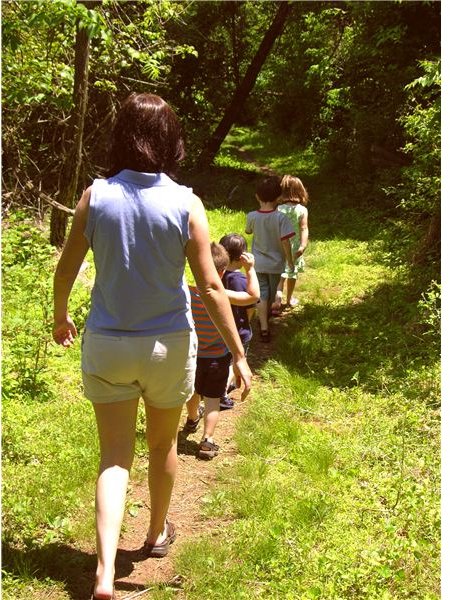Take Your Preschool Class on a Walk: Educational Summer Activity on Learning Through your Senses
Children have an inherent sense of wonder about their world that can be lost if not developed. Walks, whether in the playground, a nearby park, or can provide information, ideas, and questions to motivate many activities that teach about nature. When children “walk with their eyes,” they learn to observe both natural and man-made beauty in their surroundings. Use walks during the summer not only to give your child fresh air and exercise, but also gives them the opportunity to use their senses to capture the beauty of nature.
Prior to walking, talk to the children about the importance of listening to keep safe. Always listen for instructions from the teacher or adult helper. Teach your students to play Freeze and when you shout freeze, everyone must stop immediately. Younger children (ages 2 and 3) may feel more secure when they walk in line holding onto a rope.
Listening Walk
Take a listening walk and hone in on the sounds throughout this event. Listen for sounds that are pleasing and some that are not. Identify as many as possible and mimic them, for examples rain with its “drip, drip, drop”, the wind sounding like “oooooo”, the birds singing “tweet, tweet, tweet”, and locusts “buzzing.” Which sounds do you hear from nature? Can you mimic others that are man-made? Are there different sounds in each of the four seasons?
Color Walk
In the classroom, walk around with the children and talk about the colors you see. The teacher can use descriptive words to enhance the colors, such as bright, dark, soft, glowing, etc. As you plan on a color walk, ask the children to predict what colors they will see outdoors. As you walk together, tell the children to focus and choose one color that they like the best. When you get back to the classroom, invite the students to draw a picture of the object and color they chose from the walk. Share these pictures with the class, having each child express why it was chosen and any other information they would like to express.
Pattern Walk
Can you see patterns in nature? Before taking your walk, practice pattern recognition with the use of pictures, blocks, and colorful pegs or beads. In nature, you can show children examples of branches and plants with leaves. Some leaves grow in a balanced pattern (on each side of the stem) while others grow in a spiral or staggered pattern. Look for other patterns on roofs of buildings, brick walls, sidewalks, fences, gardens, and landscapes.
Smelling Walk
Walk through a garden, a greenhouse, a grocery store, and past restaurants. What kinds of smells tell us that we are on a busy street? In the park? Talk about pleasant smells, unpleasant smells, smells from nature, and smells that are man-made. Stop for a few minutes and take time to just SMELL. How does the earth smell when digging in the dirt? How does it smell if digging in a sand box? How does the air smell when in a park or garden?
Touch Walk
As you embark on a touch walk, instruct the children to touch objects as “light as a butterfly’s kiss.” Give the children opportunities to lightly touch a leaf, the trunk of a tree, the petal of a flower, a rock, a fence, and so on. Do tell children never to touch insects or animals that might harm them. Talk with the children and ask what differences they felt. Did objects feel different in the sun versus things in the shade?
Go on a Gathering Walk
This time, supply the children with paper bags. Tell them to bring back things from nature that can be used in art. Paintbrushes from nature could be leaves, a feather, and twigs. Acorns, pine cones, and small rocks can be used to stamp with. Collect interesting items that can be glued onto cardboard to make a nature collage, such as small pebbles, plants, sand, or even sea shells if you walk near the beach.
Make walking a part of your weekly or even daily curriculum. During the summer, walking will teach children about the beauty of nature and enjoying it through their senses. Plan to take the same route at different times of the year, so children can see that things don’t always stay the same. Each season reveals something new and wonderful!
Sources:
- First Teacher Newsletter, Volume 15, July/August 1994
- Personal Experience
Photo credit: by phaewilk
